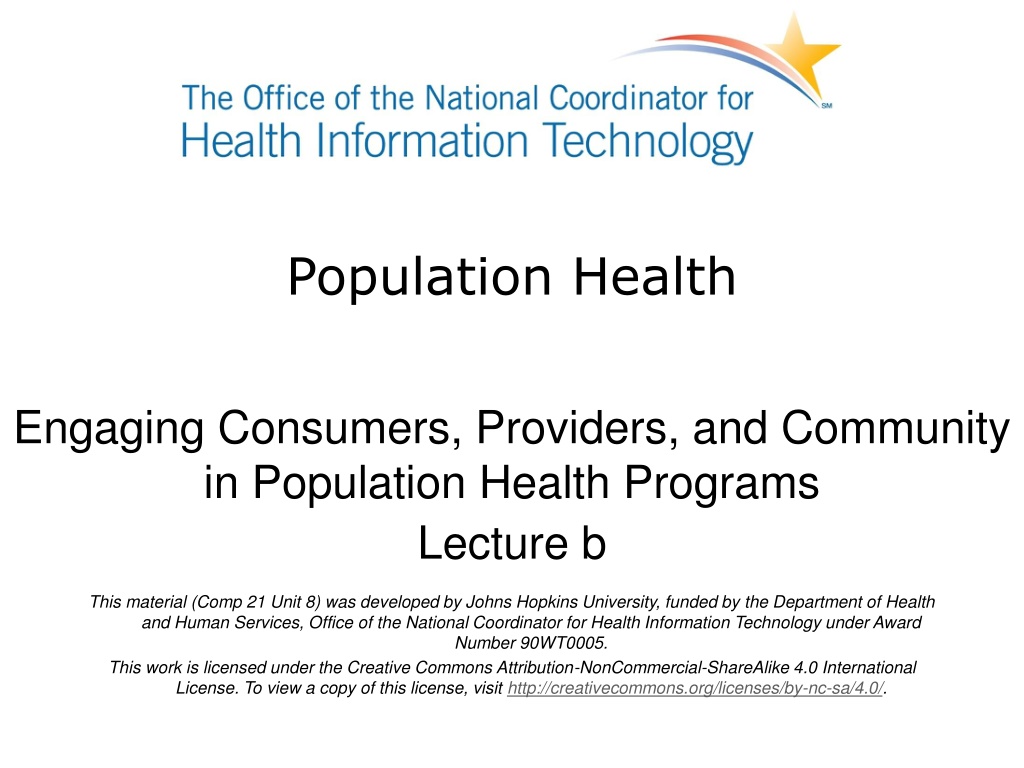Understanding Behavior Change Models in Population Health Programs
Explore behavior change models in population health programs, such as the Health Belief Model, Transtheoretical Model, and Chronic Care Model. Learn about theories like Theory of Reasoned Action/Theory of Planned Behavior and their impact on promoting healthy lifestyle choices. Empower individuals to become better self-managers through systematic understanding and application of these models.
- Behavior Change Models
- Population Health Programs
- Health Promotion
- Health Belief Model
- Chronic Care Model
Uploaded on Oct 07, 2024 | 0 Views
Download Presentation

Please find below an Image/Link to download the presentation.
The content on the website is provided AS IS for your information and personal use only. It may not be sold, licensed, or shared on other websites without obtaining consent from the author. Download presentation by click this link. If you encounter any issues during the download, it is possible that the publisher has removed the file from their server.
E N D
Presentation Transcript
Population Health Engaging Consumers, Providers, and Community in Population Health Programs Lecture b This material (Comp 21 Unit 8) was developed by Johns Hopkins University, funded by the Department of Health and Human Services, Office of the National Coordinator for Health Information Technology under Award Number 90WT0005. This work is licensed under the Creative Commons Attribution-NonCommercial-ShareAlike 4.0 International License. To view a copy of this license, visit http://creativecommons.org/licenses/by-nc-sa/4.0/.
Engaging Consumers, Providers, and Community in Population Health Programs Learning Objectives Lecture b Compare behavior change models. 2
Some Definitions: Health Models Health promotion: can be defined as the process of empowering people to make healthy lifestyle choices and motivating them to become better self-managers. Theory: a theory presents a systematic way of understanding events; it is a set of concepts, definitions, and propositions that explain such events by demonstrating the relationships between variables. Models: models are graphic or mathematical representations of a theory s constructs and how they interact. 3
Types of Models 1 Health Belief Model: many of these theories highlight the importance of self- efficacy in predicting behavior change. People with high self-efficacy believe that they are capable of performing in a certain way to achieve set goals. People with low self-efficacy believe that they do not have the power to affect their own performance or outcomes. 4
Types of Models 2 Transtheoretical Model (Stages of Change Model): individuals move through stages: 1) being either aware or unaware of a problem with their behavior with no thought to change (precontemplation); 2) wanting to change behavior (contemplation); 3) making imminent plans to change (preparation); 4) exhibiting the new behavior (action); 5) maintaining the new behavior over an extended period of time (maintenance); 6) stopping the behavior (termination). Theory of Reasoned Action/Theory of Planned Behavior: intentions to engage in activity are a good predictor of future physical activity; intentions among individuals vary due to the influences of personal attitudes and adherence to social norms. 5
Types of Models 3 Chronic Care Model: many patient- centered care programs are based on the need to address consumers chronic illnesses. 6
Overview of the Health Belief Model 8.02 Figure. Adapted by Eric W. Ford, PhD, 2016. 7
Challenges Defined in the Health Belief Model Perceived susceptibility: perception of personal vulnerability to a condition. Perceived severity: evaluation of medical/clinical consequences (death, disability, pain) and social consequences (work, family life, social relations). Perceived benefits of action: perception of feasibility and efficacy of action. Perceived barriers: perceptions of action as expensive, dangerous, unpleasant, inconvenient, time-consuming. 8
Description of the Health Belief Model 8.03 Figure. Adapted by Eric W. Ford, PhD, 2016. 9
Overview of the Theory of Planned Behavior Source: Ajzen, I. (1991, December). The theory of planned behavior. Organizational Behavior and Human Decision Processes, 50(2), 179 211. 8.04 Figure. Adapted by Eric W. Ford, PhD, 2016. 10
Definitions of TPB Constructs Perceived behavioral control: perceived control over the behavior. Control belief: perceived likelihood of occurrence of each facilitating or constraining condition. Perceived power: perceived effect of each condition in making performance difficult or easy. 11
Description of the Theory of Planned Behavior Source: Ajzen, I. (1991, December). The theory of planned behavior. Organizational Behavior and Human Decision Processes, 50(2), 179 211. 8.05 Figure. Adapted by Eric W. Ford, PhD, 2016. 12
Individual versus Ecological Models Individual models are good for identifying the program elements that are needed to change a person s behaviors. One limitation that is often cited is that these models neglect important aspects of the environment that influence the behaviors being targeted. E.g., healthy dining options on fast food restaurants menus. 13
Why Use a Socio-Ecological Model? It s very difficult to change human behavior! Human behavior is influenced by multiple factors; socio-ecological models help to identify opportunities to promote participation in physical activity. When multiple levels of influence are addressed at the same time, change in behavior is more likely to be successful and sustained. 14
Components of the Social- Ecological Model (SEM) Intrapersonal. Perceived environment. Behavior: active living domains. Behavior settings: access and characteristics. Policy environment. 15
The Ecological Model 8.06 Figure. Sallis, J. F., et al, 2006. 16
Overview of the Chronic Care Model 8.07 Figure. The MacColl Institute. 17
Toward a Chronic Care Oriented System Reviews of interventions in other conditions show that practice changes are similar across conditions. Integrated changes with components directed at: Use of non-physician team members. Planned encounters. Modern self-management support. Intensification of treatment. Care management for high-risk patients. Electronic registries. 18
Description of the Chronic Care Model 8.08 Figure. The MacColl Institute. 19
Engaging Consumers, Providers, and Community in Population Health Programs Summary Lecture b Theories and models can help guide the building of effective patient engagement programs. Both individual and ecological models inform the design for patient engagement interventions. Ecological models often include aspects of health information that need to be in place for effective patient engagement. 20
Engaging Consumers, Providers, and Community in Population Health Programs References Lecture b 1 References Bodenheimer, T., Wagner, E. H., & Grumbach, K. (2002, October 16). Improving primary care for patients with chronic illness: The chronic care model, Part 2. Journal of the American Medical Association, 288(15), 1909 1914. Davis, F. D., Bagozzi, R. P., & Warshaw, P. R. (1989). User acceptance of computer technology: A comparison of two theoretical models. Management Science, 35(8), 982 1003. Smith, D., et al. (2006). Live it up 2: VCE Physical Education Units 3 & 4. Australian Council for Health, Physical Education and Recreation, Queensland. Wagner, E. H., Austin, B. T., Davis, C., Hindmarsh, M., Schaefer, J., & Bonomi, A. (2001, November December). Improving chronic illness care: Translating evidence into action. Health Affairs (Millwood), 20(6), 64 78. Wagner, E. H., Davis, C., Schaefer, J., Von Korff, M., & Austin, B. (1999). A survey of leading chronic disease management programs: Are they consistent with the literature? Managed Care Quarterly, 7(3), 56 66. 21
Engaging Consumers, Providers, and Community in Population Health Programs References Lecture b 2 Charts, Tables, Figures 8.02 Figure: Eric W. Ford, PhD, Department of Health Policy and Management, Bloomberg School of Public Health, Johns Hopkins University (2016). The Health Belief Model. Adapted from Janz, N. K., & Becker, M. H. (1984, Spring). The Health Belief Model: A decade later. Health Education Quarterly, 11(1), 1 47. 8.03 Figure: Eric W. Ford, PhD, Department of Health Policy and Management, Bloomberg School of Public Health, Johns Hopkins University (2016). The Health Belief Model. Adapted from Janz, N. K., & Becker, M. H. (1984, Spring). The Health Belief Model: A decade later. Health Education Quarterly, 11(1), 1 47. 8.04 Figure: Eric W. Ford, PhD, Department of Health Policy and Management, Bloomberg School of Public Health, Johns Hopkins University (2016). Adapted from Ajzen, I. (1991, December). The theory of planned behavior. Organizational Behavior and Human Decision Processes, 50(2), 179 211. 8.05 Chart: Health, Johns Hopkins University (2016). Adapted from Ajzen, I. (1991, December). The theory of planned behavior. Organizational Behavior and Human Decision Processes, 50(2), 179 211. 8.06 Figure: Sallis, J. F., Cervero, R. B., Ascher, W., Henderson, K. A., Kraft, M. K., & Kerr, J. (2006). An ecological approach to creating active living communities. Annual Review of Public Health, 27, 297 322. Used with permission. 22
Engaging Consumers, Providers, and Community in Population Health Programs References Lecture b 3 Charts, Tables, Figures 8.07 Figure: The MacColl Institute. ACP-ASIM Journals and Books. Retrieved April 14, 2016, from http://www.improvingchroniccare.org/index.php?p=Chronic+Care+Model&s=124. Used with permission. 8.08 Figure: The MacColl Institute. ACP-ASIM Journals and Books. Retrieved April 14, 2016, from http://www.improvingchroniccare.org/index.php?p=Chronic+Care+Model&s=124 Used with permission. 23
Population Health Engaging Consumers, Providers, and Community in Population Health Programs Lecture b This material (Comp 21 Unit 8) was developed by Johns Hopkins University, funded by the Department of Health and Human Services, Office of the National Coordinator for Health Information Technology under Award Number 90WT0005. 24























